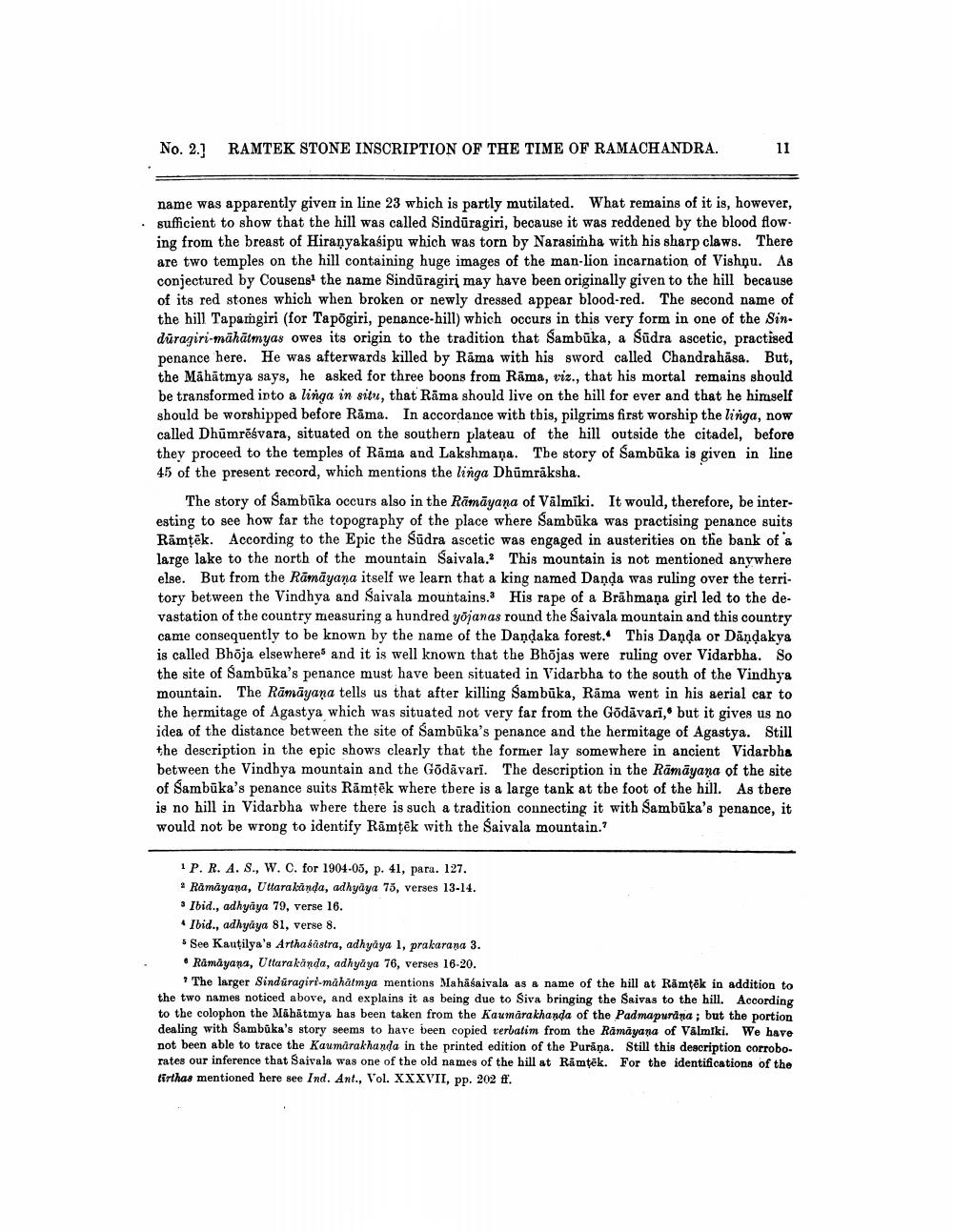________________
No. 2.1 RAMTEK STONE INSCRIPTION OF THE TIME OF RAMACHANDRA.
11
name was apparently given in line 23 which is partly mutilated. What remains of it is, however, sufficient to show that the hill was called Sindūragiri, because it was reddened by the blood flow ing from the breast of Hiranyakasipu which was torn by Narasimha with his sharp claws. There are two temples on the hill containing huge images of the man-lion incarnation of Vishņu. As conjectured by Cousenst the name Sindūragiri may have been originally given to the hill because of its red stones which when broken or newly dressed appear blood-red. The second name of the hill Tapamgiri (for Tapõgiri, penance-hill) which occurs in this very form in one of the Sin. dūraqiri-māhātmyas owes its origin to the tradition that Sambūka, a Sūdra ascetic, practised penance here. He was afterwards killed by Rama with his sword called Chandrahāsa. But, the Māhātmya says, he asked for three boons from Rāma, viz., that his mortal remains should be transformed into a linga in situ, that Rāma should live on the hill for ever and that he himself should be worshipped before Rāma. In accordance with this, pilgrims first worship the linga, now called Dhūmrēśvara, situated on the southern plateau of the hill outside the citadel, before they proceed to the temples of Rāma and Lakshmana. The story of Sambūka is given in line 45 of the present record, which mentions the linga Dhūmrāksha.
The story of Sambūka occurs also in the Rāmāyana of Vālmīki. It would, therefore, be interesting to see how far the topography of the place where Sambūka was practising penance suits Rämtēk. According to the Epic the Sūdra ascetic was engaged in austerities on the bank of s large lake to the north of the mountain Saivala. This mountain is not mentioned anywhere else. But from the Rāmāyana itself we learn that a king named Danda was ruling over the territory between the Vindhya and Saivala mountains. His rape of a Brāhmaṇa girl led to the devastation of the country measuring a hundred yojanas round the Saivala mountain and this country came consequently to be known by the name of the Dandaka forest. This Danda or Dāndakya is called Bhöja elsewhere and it is well known that the Bhõjas were ruling over Vidarbha. So the site of Sambūka's penance must have been situated in Vidarbha to the south of the Vindhya mountain. The Rāmāyana tells us that after killing Sambūka, Rāma went in his aerial car to the hermitage of Agastya which was situated not very far from the Godavari, but it gives us no idea of the distance between the site of Sambūka's penance and the hermitage of Agastya. Still the description in the epic shows clearly that the former lay somewhere in ancient Vidarbha between the Vindhya mountain and the Gödāvari. The description in the Rāmāyana of the site of Sambūka's penance suits Rämtēk where there is a large tank at the foot of the hill. As there is no hill in Vidarbha where there is such a tradition connecting it with Sambūka's penance, it would not be wrong to identify Rāmtēk with the Saivala mountain.?
1 P. R. A. S., W. C. for 1904-05, p. 41, para. 127.
Ramayana, Uttarakānda, adhyāya 75, verses 13-14. . Ibid., adhyaya 79, verse 16. • Ibid., adhyāya 81, verse 8.
See Kautilya's Arthasāstra, adhyaya 1, prakarana 3. • Ramayana, Uttara kända, adhyaya 76, verses 16-20.
* The larger Sinduragiri mahatmya mentions Mahāsaivala as a name of the hill at Rämtek in addition to the two names noticed above, and explains it as being due to Siva bringing the Saivas to the hill. According to the colophon the Mahatmya has been taken from the Kaumarakhanda of the Padmapurina; but the portion dealing with Sambuka's story seems to have been copied terbatim from the Ramayana of Valmiki. We have not been able to trace the Kaumarakhanda in the printed edition of the Purana. Still this description corroborates our inference that Saivala was one of the old names of the hill at Rämtēk. For the identifications of the tirthas mentioned here see Ind. Ant., Vol. XXXVII, pp. 202 ft.




